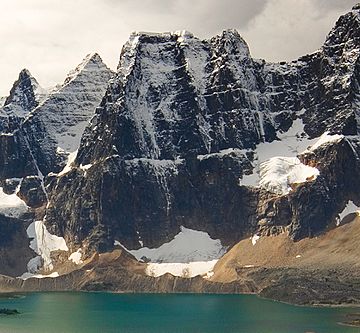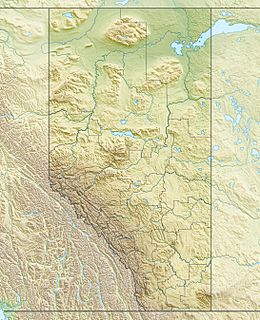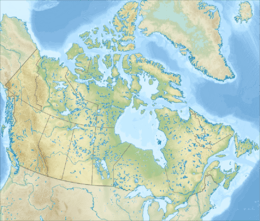Oubliette Mountain facts for kids
Quick facts for kids Oubliette Mountain |
|
|---|---|

Oubliette Mountain above Amethyst Lakes
|
|
| Highest point | |
| Elevation | 3,070 m (10,070 ft) |
| Prominence | 160 m (520 ft) |
| Parent peak | Dungeon Peak (3129 m) |
| Listing | Mountains of Alberta Mountains of British Columbia |
| Geography | |
| Location | Alberta British Columbia |
| Parent range | Park Ranges Canadian Rockies |
| Topo map | NTS 83D/09 |
| Geology | |
| Age of rock | Cambrian |
| Type of rock | Quartzite |
| Climbing | |
| First ascent | 1932 W.R. Hainsworth, M.M. Strumia, Hans Fuhrer |
Oubliette Mountain is a tall mountain in Canada, standing at 3,070 meters (about 10,072 feet) high. It's located right on the border between Jasper National Park in Alberta and Mount Robson Provincial Park in British Columbia. This mountain is part of a group of peaks called The Ramparts, found in the beautiful Tonquin Valley within the Canadian Rockies.
The name "Oubliette" is quite interesting! An oubliette is a secret dungeon that you can only get into through a trapdoor in its ceiling. The person who came up with this unique name was Cyril G. Wates. The closest taller mountain to Oubliette Mountain is Dungeon Peak, which is about 1 kilometer (0.6 miles) away to the northwest.
Contents
Mountain History and First Climbs
Oubliette Mountain was first climbed in July 1932. The climbers were William Hainsworth and Max Strumia, and they had a guide named Hans Fuhrer. This was the very first ascent of the mountain.
Later, on July 27, 1962, a different climbing route was explored. This route, called the East Buttress, was first climbed by Fred Beckey, Brian Greenwood, and Don Gordon. This challenging climb is even mentioned in Fred Beckey's famous book, "Fred Beckey's 100 Favorite North American Climbs".
Mountain Weather and Climate
Oubliette Mountain has a subarctic climate. This means it has very cold and snowy winters, but its summers are usually mild. Temperatures can drop below -20 °C (which is -4 °F), and with the wind, it can feel even colder, sometimes below -30 °C (-22 °F).
The best time to climb Oubliette Mountain is usually in July and August. However, these months are also when mosquitoes are most active, so climbers need to be prepared for them! The water that melts from Oubliette Mountain flows into different rivers. On the east side, the water goes into the Athabasca River, and on the west side, it flows into the beginning of the Fraser River.
How Oubliette Mountain Was Formed
Oubliette Mountain is made of a type of rock called quartzite. This rock was formed a very long time ago, during a period known as the Cambrian period.
Millions of years later, during an event called the Laramide orogeny, the rocks that make up Oubliette Mountain were pushed upwards. They were even pushed over the top of younger rocks, creating the mountain we see today.
Images for kids
-
Sunrise and cloud shadows on the Tonquin Valley Ramparts. Oubliette Mountain is on the left, Dungeon Peak is in the middle, and Redoubt Peak is on the right.



